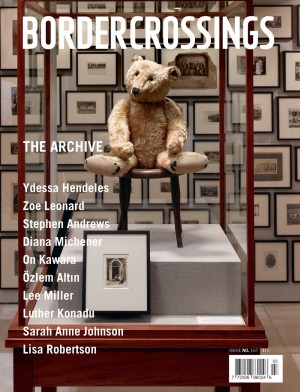John Adams Griefen
John Griefen’s paintings have always looked easy: easy to paint, easy to get. They’ve never looked studied; they’ve never looked knowing. There’s an innocent quality about them; they seem without guile. Yet, for all their apparent ease, they present a stiff challenge to taste. Their very ease provokes resistance, resistance, I suspect, of the “is that all there is?” variety: Is that all there is to a painting?
I resisted, myself, when I first saw a Griefen painting more than two decades ago. It was included, alongside paintings by more familiar artists, in an exhibition entitled “The New Generation,” selected by Kenworth Moffett for the Emmerich Gallery in New York. Griefen’s painting was disarming in its simplicity: no more than a sweep of brown paint fading through buff to bare canvas. It looked like a giant rubbing depicting the bumps and depressions of a studio floor. Yet, despite its simplicity, it stayed with me. It made me curious to see more.
The more that I saw were in keeping with my initial impression. Griefen was obviously an all-over painter in the tradition of Pollock, Olitski and Poons. But all-over painting after them seemed much of a muchness, a genre beset by dullness. Most artists who attempted it sank dry holes. But Griefen, the simplest of them all, the all-over painter who used the fewest colours and the least pictorial incident, was by no means dull. How could this be? His development in the 1980s and ’90s offered few clues.

John Adams Griefen, acrylic on canvas, 112 1/4 x 63”. Courtesy of the artist. Salander-O’Reilly Galleries, New York.
Neutral tints—buffs, browns, blacks—dominated his art during those years, reinforcing an impression of austerity. Yet within these strictures his paintings blossomed. Their paint surfaces thickened and spread, progressing from the aforementioned rubbings (a kind of modernist sfumato) to applications that seemed little more than a casual swirl or sweep within the bounds of a picture rectangle. Their persistent neutral colour reined in a growing sensuality in their paint handling. Then, around the turn of the millennium, saturated colour began to appear. The change was unexpected. Here was an edge that cut.
Strong colour having been absent from painterly abstraction of the 1980s and ’90s, there was the sense that texture and saturated colour on large paintings couldn’t coexist, that strong colour cancelled texture. But in Griefen’s hands it didn’t; it began to sing. The thick paint in his paintings never dragged colour down; it seemed instead to float in the surface. This achievement may have been assisted by his use of a light-bodied acrylic gel developed by Golden Paints, a medium Griefen described as handling “like shaving cream.” But the lightness was due as much to a feathery touch, a touch more commonly associated with thin, transparent paints. Like watercolour, paint also seems to float upon the surface of Griefen’s recent paintings; it never looks forced, never worried.
The sensation of easiness suggested by his paintings has to do with their simplicity and directness, but that directness is accompanied by a disarming subtlety: a figure covers a ground, or seems to; a figure gives way to a ground, or does it? In the past, what figure there was swarmed across the canvas, often leaving bits of the ground peeking through at corners and edges. In his recent work, even those corners and edges are gone. Paint now covers the entire canvas in a single sweep of colour. Nevertheless, the feeling of figure on ground persists. The ground seems to infuse the surface like an aroma and the paintings seem airier than ever, even when dark. Their surfaces breathe easily and naturally in a single and complete exhalation.
As such, they remain easy to appreciate, easy so long as expectations don’t get in the way, the “is that all there is” of art. I suspect that their seeming lack of complexity, their lack of subject and lack of accountable issues are part and parcel of the resistance they continue to provoke. If they’re at a cutting edge, the edge isn’t the expected one.
That these are stripped-down paintings, even reduced ones, goes without saying. But for all their simplicity they’re hardly minimal—at least not in the common art world sense. Minimal paintings leave an impression of intellectual rigour, of the working-out of a theory or conception. They tend to be puritanical art items; they aim to look tough. Griefen’s paintings suggest none of that. Reduced to an essence that’s entirely aesthetic, they neither postulate nor demonstrate. They’re unabashedly rigourless. They look as if the artist had just swept paint on and left the room, leaving the result for our eyes to savour: voila, a picture! Griefen makes it look so easy.
Whether that appearance of ease is fact or fiction is a question that’s quite properly left begging. In the long run, it doesn’t matter, for Griefen, like the hedgehog, knows one big thing—that art should be a gift, should be an indulgence for the eyes, a sheer pleasure in the seeing. That’s what the look of ease is for: ease for the eyes. Griefen’s paintings are the antithesis of the minimal. They bask in their beauty. ■
“John Adams Griefen: Recent Paintings” was on exhibit at the Salander O’Reilly Galleries in New York from June 29 to July 31, 2004.
Terry Fenton is a painter and writer who lives in Saskatoon.

